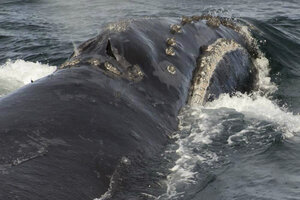Scientists celebrate rare sighting of endangered whales in Bering Sea
A research vessel located and photographed two critically endangered North Pacific right whales off the coast of Alaska.

A North Pacific right whale swims in the Bering Sea west of Bristol Bay, on Aug. 6, 2017. Jessica Crance, a research biologist with the National Oceanic and Atmospheric Administration, was able to use acoustic equipment to find and photograph two of the extremely endangered whales and obtain a biopsy sample from one. NOAA estimates only 30 to 50 eastern stock North Pacific right whales still remain.
Uncredited/NOAA Fisheries/AP
Anchorage, Alaska
Federal researchers studying critically endangered North Pacific right whales sometimes go years without finding their subjects. Over the weekend they got lucky.
A research vessel in the Bering Sea photographed two of the animals Sunday and obtained a biopsy sample from one, the National Oceanic and Atmospheric Administration announced Thursday.
NOAA Fisheries research biologist Jessica Crance was on board the Yushin Maru 2, when the whales were spotted. The ship is part of the Pacific Ocean Whale and Ecosystem Research program, a collaborative effort headed by the International Whaling Commission. Using an acoustic recorder, and between sounds of killer whales and walrus, Ms. Crance picked up faint calls of a right whale east of Bristol Bay, Alaska.
The sounds came from an estimated 10 to 32 miles away and the ship headed west, she said in a blog entry. After four and a half hours, despite the presence of minke and humpback whales, and only a few calls from the right whales, the rare animals were spotted.
The two right whales are part of the eastern stock that number just 30 to 50 whales, said Phillip Clapham, head of the cetacean program at NOAA's Alaska Fisheries Science Center in Seattle.
A French whaling ship recorded the first kill in 1835 and reported seeing "millions" of others. That claim was exaggerated but it drew hundreds of other whalers to the Gulf of Alaska and the Bering Sea, Dr. Clapham said.
Within 14 years, Clapham said, the overharvest of the slow, buoyant animals sent many whalers through the Bering Strait to hunt bowhead whales instead.
A modest comeback of right whales in the 20th century was derailed when Soviet whalers in the 1960s ignored critically low numbers and illegally killed eastern stock right whales in the Gulf of Alaska, Clapham said.
The right whale sampled Sunday had been seen eight times before, Clapham said. The last time was a decade ago.
A biopsy sample, he said, can positively identify the animal, reveal its gender, indicate whether it's pregnant, and reveal information on diet and reproductive hormones.
Studying North Pacific right whales is complicated by the expense of reaching their habitat in the Gulf of Alaska and the Bering Sea. Critical data remains unknown, including their winter habits and many of their preferred summer feeding areas for copepods, a tiny crustacean plankton.
"We don't know what habitats continue to be important to the species," Clapham said.
The biggest threats to the animals are fishing gear entanglements and ship strikes, Clapham said.
This story was reported by The Associated Press.

